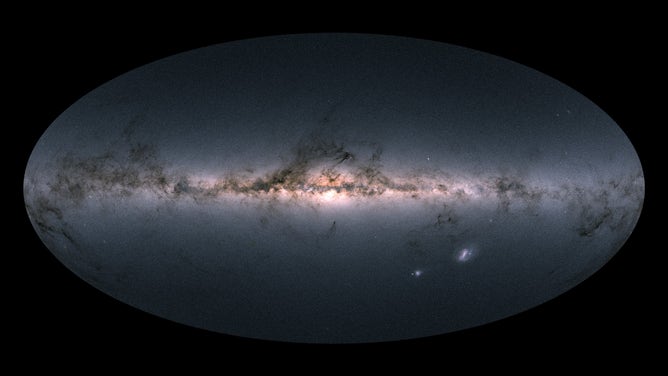European space telescope launched from Florida will study mysteries of universe expansion
The mission is designed to answer one of the biggest mysteries about the cosmos. The universe is ever expanding, but that process began ramping up about 6 billion years ago, and no one knows why.

ESA's Gaia satellite map of the Milky Way and neighboring galaxies. (Image: ESA/Gaia Data Processing and Analysis Consortium (DPAC); A. Moitinho / A. F. Silva / M. Barros / C. Barata, University of Lisbon, Portugal; H. Savietto, Fork Research, Portugal.
(ESA)
A European Space Agency space telescope launched this weekend on a SpaceX rocket from Florida will peer back into galactic history to uncover why the universe's expansion is accelerating.
ESA's Euclid spacecraft launched at 11:12 a.m. EDT Saturday on a Falcon 9 rocket from Cape Canaveral Space Force Station.
The mission is designed to answer one of the biggest mysteries about the cosmos. The universe is ever expanding, but that process began ramping up about 6 billion years ago, and no one knows why.
What are dark energy and dark matter?
"Dark energy" refers to the mystery cause of the expansion of the Universe, and "dark matter" is the name of what causes the growth of cosmic structures, like galaxies. Scientists are still trying to figure out what dark matter and energy are. This field of study around the changes in our universe is known as cosmology.
It's estimated dark energy makes up 70% of the cosmos and dark matter is 25%, meaning we don't fully understand 95% of what makes up the mass of our universe.
BUILDING BLOCKS FOR LIFE FOUND IN SPACE BY NASA’S JAMES WEBB SPACE TELESCOPE
According to ESA, the space telescope was designed to answer fundamental questions about the universe, including how the universe's expansion has changed over time and the forces behind it.
How will Euclid study cosmology?

A photo taken on June 27, 2023 shows the last glimpse of ESA’s Euclid space telescope before it was encapsulated by a SpaceX Falcon 9 rocket fairing. (Image: SpaceX/ESA)
Once in orbit, Euclid will live at the second Lagrange Point or L2, about 1 million miles away, with the Earth between the Sun and the telescope, according to the ESA. This is the same orbit as the James Webb Space Telescope and ESA's star-surveyor, the Gaia satellite. The orbit was chosen because it's an excellent way to view the more extensive universe without Earth's shadow interfering.
Euclid has two instruments, a visible-wavelength camera known as the VISible instrument and the Near-Infrared Spectrometer and Photometer known as NISP.
Using visible and infrared light, ESA's Euclid space telescope will search for dark energy and its influence on the universe. To achieve this, Euclid will take images, creating a 3D map of one-third of the sky, viewing its evolution over 10 billion years.
NASA is contributing hardware and science team members to the Euclid mission. Japan and Canada also contributed to the mission.
In another four years, NASA will launch another space telescope known as the Nancy Grace Roman Space Telescope, which will also study the origins and changes in the universe.